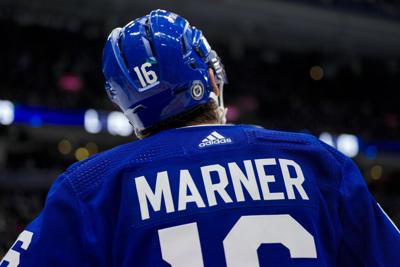With the NHL salary cap firmly set to rise, players coming up on free agency are about to benefit.
But that could make things very complicated for Mitch Marner and the salary structure of the Maple Leafs. Maybe for John Tavares and Matthew Knies, too.
The cap has been set artificially low since 2020, so that players — entitled to half the league’s hockey-related revenue — could pay back owners for money lost during the first two years of the COVID-19 pandemic, when many games were played without fans in the seats.
The NHL and players’ association have agreed that this season’s $88-million (U.S.) ceiling will rise to:
- $95.5 million for 2025-26
- $104 million for 2026-27
- $113.5 million for 2027-28
In the grand scheme of things, it means business is good and revenue is on the rise. It also means more money for teams to spend, and for free agents to receive. The salary floor — the least that each team can spend on players — will go up. So will minimum salaries.
Ekman-Larsson led Leafs in ice time and was a plus when most of his teammates put up minuses — including Rielly — in a three-game losing streak.
Ekman-Larsson led Leafs in ice time and was a plus when most of his teammates put up minuses — including Rielly — in a three-game losing streak.
The biggest issue for the Leafs is Marner’s status as a pending unrestricted free agent.
When Marner signed a six-year, $65.41-million contract extension in 2019, the average annual value was $10.9 million. At the time, that was third on the team behind Auston Matthews ($11.634 million) and Tavares ($11 million). Matthews has since signed another extension through 2028, at $13.25 million per season.
Going back to the days of Gordie Howe, teams have wanted their best player to also be their highest paid. That’s what the Leafs set out to do with Matthews, and was part of the reason why the Colorado Avalanche recently traded pending unrestricted free-agent Mikko Rantanen (to keep Nathan MacKinnon at the top of the heap).
But with the new cap numbers, Marner could justify asking for more than Matthews. Â And an extra $7.5 million of spending room for every team gives him more leverage.Â
Ditto Tavares. It’s widely assumed the former captain will re-sign for less than the $11-million average he got as a free agent in the summer of 2018. But with extra money in the system, it may not drop that far — an $8-million average is not that bad a bet.
As for Knies, who makes $925,000 per season, he’s heading into restricted free agency for the first time. His value to the Leafs is much higher, and with more money in the system there’s the potential for an offer sheet from another team, after the St. Louis Blues poached two restricted free agents from the Edmonton Oilers last summer. Â
After Friday’s blockbuster trade of Rantanen in a contract year, you can almost hear Joe Sakic’s front office saying: We can’t become the Leafs.
After Friday’s blockbuster trade of Rantanen in a contract year, you can almost hear Joe Sakic’s front office saying: We can’t become the Leafs.
For Marner, the solution may be in the percentages.
When he signed that extension in 2019, his average annual value equalled 13.37 per cent of the cap. When Matthews signed his latest deal two summers ago, his average was 15.07 per cent. (His first extension was 14.27 per cent.)
Marner could remain second fiddle to Matthews by asking for 13.37 per cent of the new cap. That would give him a raise to $12.78 million, second to Matthews and still in front of William Nylander ($11.5 million on average, or 12.93 per cent of the cap).
How much the pecking order matters to Marner, Matthews and the Leafs will become evident through the negotiations. It may not matter to Matthews at all. He’ll be a free agent at age 30 in 2028, when the league cap could be even higher than the projected $113 million. Â






























To join the conversation set a first and last name in your user profile.
Sign in or register for free to join the Conversation